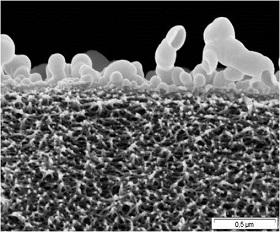Using AI to control energy for indoor agriculture
30 September 2024
Published online 2 July 2012

While Saudi Arabia may have ample reserves of oil and gas, fresh water remains scarce in the desert kingdom. Scientists at the King Abdullah University of Science and Technology (KAUST) are turning to the sea to meet the country's agricultural demands.
Scientists at KAUST's Water Desalination and Reuse Center (WDRC), led by Suzana Nunes, a chemical engineer at WDRC, have embarked on a three-year project to develop new nanofiltration membranes to filter and desalinate seawater for use in agriculture. They "will operate at much lower pressures and require much lower energy than conventional reverse osmosis membranes," says Gary Amy, director of WDRC.
Nanofiltration membranes have filters with tiny pores with a diameter of approximately 0.001 microns, less than 1/300 of a human hair, which can remove natural organic matter and synthetic organic chemicals from water.
While reverse osmosis produces potable water from seawater by removing more than 99% of the salts, the process requires high pressure and energy. The team has not yet completed the energy and costs analyses, but Amy expects the energy usage could be reduced from 3 - 4 kwH/m3 required for reverse osmosis to less than 2 kwH/m3 with nanofiltration.
But the low energy cost of nanofiltration membranes comes with a caveat. "The new seawater nanofiltration membranes will reduce salinity by only about 50 - 75 %," says Amy.
To make the water usable, the WDRC joined the Desert Agriculture Research Initiative (DARI) at KAUST on a project to use partially desalinated seawater for irrigation of salt-tolerant crops, like date palms, onions and wheat. Farms in an integrated aquaculture-agriculture project will also grow shrimps in brackish water, using the resulting nutrient-rich wastewater to irrigate crops. "Given that Saudi Arabia has been 'mining' fossil groundwater for agriculture, this new approach represents a more sustainable practice for arid-region agriculture and aquaculture," says Amy.
The Red Sea Research Center in KAUST is studying the long-term impact that aquaculture-agriculture will have on the ecosystem as most of the high-saline and nutrient-rich wastewater from open water aquaculture farms flows back into the sea. Xabier Irigoyen, the director of the center, says there is a limit to the nutrient discharge that the sea can absorb without significant alterations. He explained: "A controlled increase of nutrients will increase planktonic production, the growth of the microalgae, and consequently there will be more food available for the higher trophic levels such as fish.
"On the other hand if the nutrient discharge is excessive there can be an uncontrolled growth of microalgae and macroalgae resulting in toxic blooms affecting coral reefs."
The project has just begun, but Amy hopes that 18 months from now his team will have some promising results on energy and costs analyses. They will also explore the possibility of tandem nanofiltration where the water passes through a second membrane for further treatment.
doi:10.1038/nmiddleeast.2012.92
Stay connected: